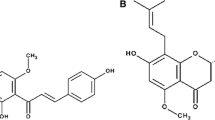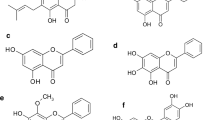Abstract
The whole-cell patch-clamp technique was applied to study the modulatory effect of resveratrol on voltage-gated potassium channel Kv1.3 expressed in human lymphocytes. Results demonstrate that application of resveratrol in the concentration range 1–200 μM inhibited the channel activity in a concentration-dependent manner to about 18% of the control value. The half-blocking concentration of resveratrol was 40.9 μM, whereas the Hill coefficient was 1.05. The inhibition was time-dependent and slowly reversible. The inhibitory effect of resveratrol was correlated in time with a significant slowing of the current activation, whereas the inactivation rate remained unaffected upon application of resveratrol. The inhibition of Kv1.3 channels was voltage-independent. The steady-state activation of the currents remained unchanged upon resveratrol application. The magnitude of the inhibitory effect of resveratrol was not altered when resveratrol was coapplied with genistein. The possible mechanism of the inhibitory effect and its significance for biological activity of resveratrol are discussed.




Similar content being viewed by others
References
Abdul M., Hoosein N. 2002. Expression and activity of potassium ion channels in human prostate cancer. Cancer Lett. 186:99–105
Abdul M., Santo A., Hoosein N. 2003. Activity of potassium channel-blockers in breast cancer. Anticancer Res. 23:3347–3351
Baur J.A., Sinclair D.A. 2006. Therapeutic potential of resveratrol: The in vivo evidence. Nat. Rev. Drug Discov. 5:493–506
Cahalan M., Wulff H., Chandy K.G. 2001. Molecular properties and physiological roles of ion channels in the immune system. J. Clin. Immunol. 21:235–252
Chandy K.G., Wulff H., Beeton C., Pennington M., Gutman G., Cahalan M. 2004. K+ channel as targets for specific immunomodulation. Trends Pharmacol. Sci. 25:280–289
Chung I., Schlichter L. 1997. Native Kv1.3 channels are upregulated by protein kinase C. J. Membr. Biol. 156:73–85
Conti M.J. 2004. Targeting K+ channels for cancer therapy. Exp. Ther. Oncol. 4:161–166
Delmas D., Lancon A., Colin D., Jannin B., Latruffe N. 2006. Resveratrol as a chemopreventive agent: A promising molecule for fighting cancer. Curr. Drug Targets 7:423–442
Felipe A., Vincente R., Villalonga N., Roura-Ferrer M., Martinez-Marmol R., Sole L., Ferres J., Condom E. 2006. Potassium channels: New targets in cancer therapy. Cancer Detect. Prev. 30:375–385
Fremont L. 2000. Minireview. Biological effects of resveratrol. Life Sci. 66:663–673
Grandos-Soto V., Arguelles C.F., Ortiz M.I. 2002. The peripheral antinociceptive effect of resveratrol is associated with activation of potassium channels. Neuropharmacology 43:917–923
Grissmer S., Nguyen A., Cahalan M. 1993. Calcium-activated potassium channels in resting and activated human T lymphocytes. J. Gen. Physiol. 102:601–630
Hamill O.P., Marty A., Neher E., Sakmann B., Sigworth F. 1981. Improved patch-clamp techniques for high-resolution current recording from cells and cell-free membrane patches. Pfluegers Arch. 39:85–100
Han Y., Zheng W., Bastianetto S., Chabot J., Quirion R. 2004. Neuroprotective effects of resveratrol against β-amyloid-induced neurotoxicity in rat hippocampal neurons: Involvement of protein kinase C. Br. J. Pharmacol. 141:997–1005
Hirano T., Kuritani T., Kishimoto Y., Yamamura Y. 1977. T cell dependency of PWM-induced Ig production by B cells. J. Immunol. 119:1235
Hu G., Gao Z. 2005. Trans-resveratrol, a red wine ingredient, inhibits voltage-activated potassium currents in rat hippocampal neurons. Brain Res. 1056:68–75
Li H., Chen S., Wu S. 2000. Evidence for the stimulatory effect of resveratrol on Ca2+ activated K+ current in vascular endothelial cells. Cardiovasc. Res. 45:1035–1045
Michalak K., Teisseyre A., Łania-Pietrzak B. 2005. Inhibition of multidrug resistance-associated protein MRP and Kv channels by natural polyphenols. Eur. Biophys. J./Biophys. Lett. 34:805, abstract P-875
Orsini F., Verotta L., Lecchi M., Restano R., Curia G., Redaelli E., Wanke E. 2004. Resveratrol derivatives and their role as potassium channel modulators. J. Nat. Prod. 67:421–426
Panyi G., Gaspar R., Krasznai J., Ameloot M., Aszalos A., Steels P., Damjanovich S. 1996. Immunosuppressors inhibit voltage-gated potassium channels in human peripheral blood lymphocytes. Biochem. Biophys. Res. Commun. 221:254–258
Pardo LA. 2004. Voltage-gated potassium channels in cell proliferation. Physiology (Bethesda) 19:285–292
Rouzaire-Dubois B., Dubois JM. 1990. Tamoxifen blocks both proliferation and voltage-dependent K channels of neuroblastoma cells. Cell. Signal. 2:387–393
Rouzaire-Dubois B., Gerard V., Dubois J.M. 1993. Involvement of K channels in quercetin-induced inhibition of neuroblastoma cell growth. Pfluegers Arch. 423:202–205
Rybalchenko V., Prevarskaya N., Van Coppenolle F., Legrand G., Lemonnier L., Bourhis X., Skryma R. 2001. Verapamil inhibits proliferation of LNCaP human prostate cancer cells influencing K+ channel gating. Mol. Pharmacol. 59:1376–1387
Teisseyre A., Michalak K. 2005. Genistein inhibits the activity of Kv1.3 potassium channels in human T lymphocytes. J. Membr. Biol. 205:71–79
Teisseyre A., Mozrzymas J.W. 2002. Inhibition of the activity of T lymphocyte Kv1.3 channels by extracellular zinc. Biochem. Pharmacol. 64:595–607
Wang Z. 2004. Roles of K+ channels in regulating tumour cell proliferation and apoptosis. Pfluegers Arch. 448:274–286
Zhang Y., Liu Y., Wang T., Li B., Li H., Wang Z., Baofeng Y. 2006. Resveratrol, a natural ingredient of grape skin: Antiarrythmic efficacy and ionic mechanisms. Biochem. Biophys. Res. Commun. 340:1192–1199
Acknowledgement
We thank our colleague from the Biophysics Department Dr. Andrzej Poła, who kindly provided blood samples for lymphocyte isolation. This work was supported by the Polish State Committee for Scientific Research funds for Wrocław Medical University.
Author information
Authors and Affiliations
Corresponding author
Rights and permissions
About this article
Cite this article
Teisseyre, A., Michalak, K. Inhibition of the Activity of Human Lymphocyte Kv1.3 Potassium Channels by Resveratrol. J Membrane Biol 214, 123–129 (2006). https://doi.org/10.1007/s00232-007-0043-8
Received:
Revised:
Published:
Issue Date:
DOI: https://doi.org/10.1007/s00232-007-0043-8




